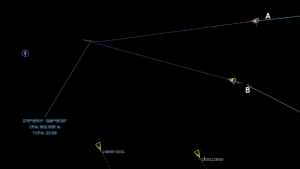The Charity
Aviation
Maritime
Collision Regulations – Rule 15 non-compliance

Initial Report
Outline:
A report received concerning non-compliance when two vessels were approaching a major port.
What the Reporter told us:
My own vessel (A) was proceeding westerly at 11kts with the other vessel (B) proceeding WNW at 11kts to the south and just forward of my beam. Her CPA was fluctuating between 0.2-0.35nm ahead. This was a crossing situation with my own vessel as the stand on vessel.
Both vessels had reported to the Vessel Traffic Service stating their intention and were listening on VHF Channel 12. As the TCPA approached ten minutes with a CPA of less than 0.25nm, I contacted vessel (B) on Channel 12 and asked his intention – he suggested that I alter course to port. I told him I would not be doing that and intended to halt the conversation there and abide by the regulations. Vessel (B) then questioned why I wouldn’t alter to port and under which Rule, which concerned me slightly.
I contacted the VTS who I expected would have wished to intervene as we were in their VTS area – they suggested I make a bridge to bridge communication with the other vessel. I then made a bold reduction in speed, which by my action alone avoided the close quarters situation and risk of collision, allowing the other vessel to pass well ahead. Rule 15 situations involving converging courses with a risk of collision seem too often to result in the give way vessel being reluctant to meet her obligations. This is something I regularly find working in the Dover Strait and English Channel. The fact that this was in pilotage waters and will be supported by the VTS recordings, should you wish to obtain them, prompted my submission. I regularly see the give way vessel not taking action in crossing situations with vessels on similar courses and speeds and hope that your publication will be able to raise awareness of the issue.

Screen dump image from the VTS recording – vessel names edited to A + B
Further Dialogue:
The VTS were contacted and, quoting the date and time of the incident, a request was made for any available records of the incident. The VTS were most helpful and provided a video recording of the VTS radar image. Unfortunately, there was no recording of the VHF channels available.
CHIRP Comment:
After discussion the members of the MAB noted the following points:
- this was a classic converging vessel situation.
- the encounter took place in daylight which added to the ambiguity of the situation. At night the cut off angles of navigation lights would have added clarity to interpreting if this was a crossing situation or an overtaking situation.
- vessel A interpreted the situation as crossing vessels governed by Rule 15.
- it is possible that Vessel B construed it to be an overtaking situation governed by Rule 13(a)
- if the above points are correct, then both vessels by their own interpretation of the situation were the stand on vessel.
- whatever the case , as the vessels drew closer both would have been governed by Rule 17(a) (ii) and ultimately by Rule 17(b).
- in the above report, vessel A acted under Rule 17(a) (ii) and complied with Rule 17(c)
- whatever the situation Colregs should work, even if a vessel fails to comply with a rule or misinterprets a situation.
- it is refreshing to note that the avoiding action taken in this case was a significant reduction in speed
Report Ends…………………







